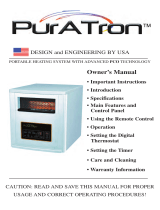Carel pCO is an advanced refrigeration control system that offers a wide range of features and capabilities to help you optimize your refrigeration system. With its user-friendly interface and powerful programming capabilities, Carel pCO is the perfect choice for a variety of refrigeration applications.
Some of the key features of Carel pCO include:
- Control and regulation of a refrigeration system with up to 3 compressors
- Display of all measured values and set-points
- Selection and modification of regulation parameters
- Indication of off-normal conditions via acoustic and visual signals
Carel pCO is an advanced refrigeration control system that offers a wide range of features and capabilities to help you optimize your refrigeration system. With its user-friendly interface and powerful programming capabilities, Carel pCO is the perfect choice for a variety of refrigeration applications.
Some of the key features of Carel pCO include:
- Control and regulation of a refrigeration system with up to 3 compressors
- Display of all measured values and set-points
- Selection and modification of regulation parameters
- Indication of off-normal conditions via acoustic and visual signals




















-
 1
1
-
 2
2
-
 3
3
-
 4
4
-
 5
5
-
 6
6
-
 7
7
-
 8
8
-
 9
9
-
 10
10
-
 11
11
-
 12
12
-
 13
13
-
 14
14
-
 15
15
-
 16
16
-
 17
17
-
 18
18
-
 19
19
-
 20
20
-
 21
21
-
 22
22
-
 23
23
-
 24
24
-
 25
25
-
 26
26
-
 27
27
-
 28
28
-
 29
29
-
 30
30
-
 31
31
-
 32
32
-
 33
33
-
 34
34
-
 35
35
-
 36
36
-
 37
37
-
 38
38
-
 39
39
Carel pCO is an advanced refrigeration control system that offers a wide range of features and capabilities to help you optimize your refrigeration system. With its user-friendly interface and powerful programming capabilities, Carel pCO is the perfect choice for a variety of refrigeration applications.
Some of the key features of Carel pCO include:
- Control and regulation of a refrigeration system with up to 3 compressors
- Display of all measured values and set-points
- Selection and modification of regulation parameters
- Indication of off-normal conditions via acoustic and visual signals
Ask a question and I''ll find the answer in the document
Finding information in a document is now easier with AI
Related papers
Other documents
-
Rasonic RPC-J21 User manual
-
Reznor RTU Installation guide
-
 EdenPURE PurATron MG2009 User manual
EdenPURE PurATron MG2009 User manual
-
Dometic PCWM-VAR Operating instructions
-
APC ACPL75191 Installation guide
-
Full Gauge Controls MT-532 Super Owner's manual
-
Alfa Network LU-VE ICM User manual
-
Emax HRSK070003 Installation guide
-
Full Gauge Controls MT-532 Super Owner's manual
-
MULTISPAN SQT-1044 Owner's manual







































